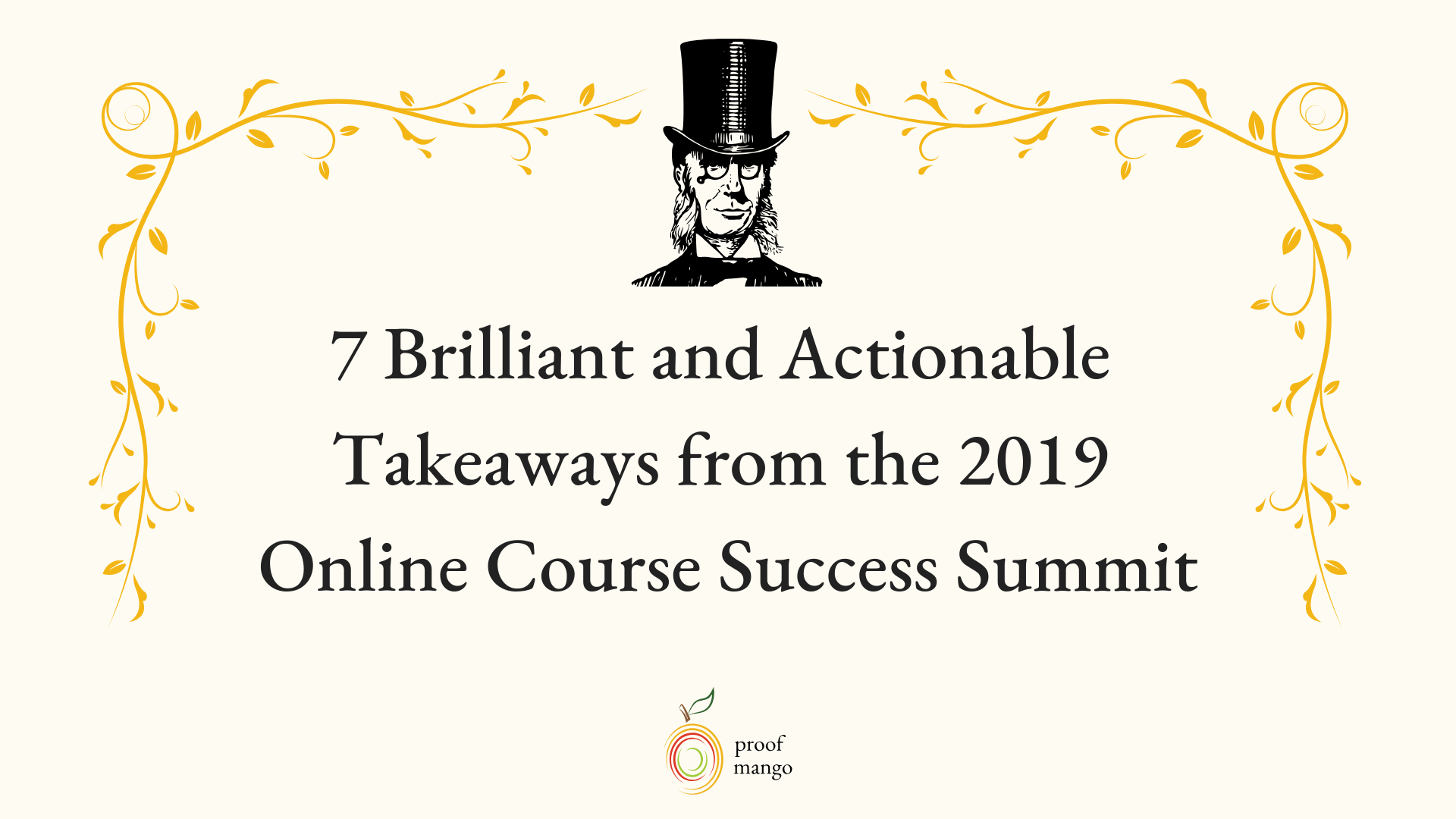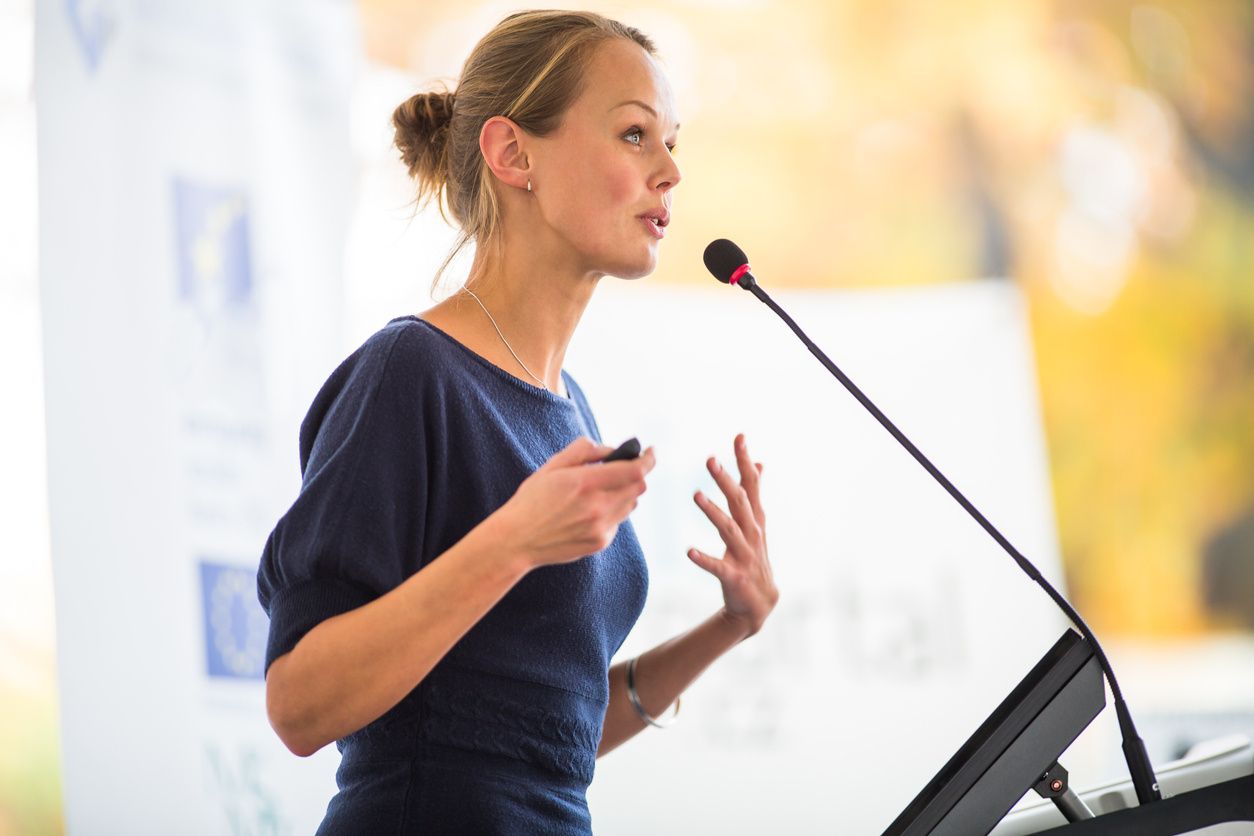The 2019 Online Course Success Summit rocked my world. After listening to almost every masterclass and interview, I noted 7 actionable takeaways that will help course creators create high-quality learning experiences and reframe their mindset around what they're capable of.
This is what obsession looks like:
Wake up, listen to the Online Course Success Summit.
Drive to work, listen to the Online Course Success Summit.
Eat dinner, workout, listen, listen, listen.
You know the drill with online summits: you have a limited number of hours to absorb the material before it goes away for good (unless you pay for it).
So when Thinkific and Carrie Rose put out the 2019 Online Course Success Summit, I made it my mission to listen to all of the interviews and masterclasses, and get as much as I could out of them while they were live.
And my obsession worked. I lost about two weeks of my life, but every minute was worth it, since I soaked up so. much. learning.
Dr. Carrie Rose, Lechon Kirb, and all of the kind people at Thinkific put on an amazing online summit that included interviews and masterclasses on:
- How to create value-based sales funnels for your course
- How to grow your email list
- How to get started with Facebook Ads and Messenger bots
- How to use social media to connect and convert your audience
The list goes on and on. And I took notes on nearly every interview and masterclass, so I could share them with hungry course creators like you, who are out there grinding.
But today, we’re not just sharing pretty quotes from the summit — we’re sharing actionable takeaways you can use to create a high-quality online course, and build a raving fan base who buys from you again and again.
Warning: you may experience some powerful shifts after reading some of these tips and strategies. We’d prefer if you commented like crazy and told us all about it.
TAKEAWAY #1: ASK Your Students What They Want, Give Tons of Value, and CARE
Some of the common questions course creators ask are:
- How do I get started creating an online course?
- How do I get social proof if I don’t have it already?
- How do I get Facebook Ads to WORK for me and sell my course?
Molly Pittman, VP of marketing at Digital Marketer, gave some great advice at the Online Course Success Summit. She said, when you’re just starting out, the best way to know what content to put in your course is to ask questions from your audience.
For example, when she was creating her course on Facebook Ads, she started by researching what questions her audience asked most. Like, how do I place the Facebook pixel on my site?
She also learned a lot by running a live course, where she got great insight after each lesson, into what she should discuss in the next lesson.
“Before you sit down to craft your outline, make a list of the questions your students have. What is the desired end result they’re trying to achieve?”
Starting with the end in mind helps you decide what to include in your course, especially if you need to trim it down. But at the end of the day, you need to ask your students what they want before you create your course (or while you create it) for them. You need to be able to meet their specific need in order for them to buy from you.
Molly also stressed the importance of adding value to your students’ lives before they buy from you. This will help with your marketing. Give students incredible information and free value.
Because if something of yours has value, people want their friends to see it, and it allows your potential students to get to know you. That way, you have an entire list of people who are interested in you and your course.
Even if they don’t buy your course today or next week, if you’re giving them value, they might want it next month or even after that. There’s no downside to building good relationships.
And lastly, you’ll want to make it known that you care. Always remember that you’re not just creating knowledge to share, you’re creating an experience for your students – a transformation.
Your students buy from you so they can experience a shift in their lives – honor your role in helping them make that shift. You’re their teacher, their guide, and they look to you for answers.
Be present and supportive to each and every student. If you’ve got thousands of students, make sure you have a support team at-the-ready to lend a helping hand to anyone who has a question.
My favorite quote on this from Molly is one I posted on the Proof Mango Instagram the other day:
Be the kind of teacher students remember.
Make It Actionable
Do some research online or in Facebook groups to see what kind of questions your students are asking. Go even further, and see if any of them want to jump on a quick call with you so you can see what they’re struggling with.
I know it sounds scary to go on actual calls with people, but I promise you, the value you’ll get from connecting with your ideal students outweighs any fear that’s holding you back.
Vow to do just one call, and see how you feel. Taking one small step forward helps you slowly start to unravel any fear you might have about connecting one-on-one with your audience.
TAKEAWAY #2: Forget Perfect, Literally
Sometimes, the only thing getting in the way of success is yourself. The Online Course Success Summit was big on strategy, but also on mindset.
And if you’ve been in business for any length of time, you know mindset is at least 80% of it.
Some of my favorite takeaways on mindset were from Carrie Rose, Chris Zaino, Shamina Taylor, Chris Winfield, and Jen Gottlieb.
They focused on the biggest thing that stops people from becoming successful in the online course space: perfection.
Perfection seems impossible to overcome, but we need to at least temporarily set it aside when we need to get things done. How do we do that?
Dr. Chris Zaino suggests being a potentialist, not a perfectionist. He says, “If you’re waiting for perfect, it’s not going to happen. It’s an excuse not to move forward.”
There’s always the potential for improvement, but do the best you can with what you’ve got, in the moment you have it.
Dr. Carrie Rose also had a great addition to this, and that is, “Version done is better than version none.”
Right? The time you spend fussing over perfection is time away from getting the thing you want done.
And think about it — if you only have two hours to work on a landing page, and at the end, you didn’t get it done because you couldn’t figure out what picture to use…will you really feel accomplished by the end of that 2-hour period? Will you really feel like you produced something?
Or do you have to keep it on your to-do list for another week because you were too busy perfecting one picture?
Shamina Taylor, another great speaker at the summit, said, “If you really believe in what you’re doing, you’ll find a way.”
And that’s the truth. Because don’t you sometimes think perfectionism is some subconscious way of intentionally keeping yourself stuck?
If you truly wanted to accomplish your goal of pairing your course with the right people, you’d find a way to do it without fussing over perfect. Perfect is only a distraction.
And in fact, Jen Gottlieb of Unfair Advantage put perfection in a different light for me. She said, “Perfect moments are the things that stay the same. They’re easy and boring. It’s the messy stuff that creates the amazing stuff.”
You have to put something out there, anything, to show what you have to offer, and even just that you exist.
Jason Alan Miller of Peaceful Media offered a masterclass on the summit about how to get yourself in the game with a minimum viable product platform. He focused on helping people set up their website and email service provider, as well as basic tracking.
One thing he said really stood out to me: He said, “Sometimes you need an ugly website just so people can SHARE you.”
How accurate is that? It’s better to have a so-so website where people can find and connect with you, than nothing at all. Nowadays, if you don’t have a website, or some landing page where people can reach you, it’s like you don’t exist.
Don’t let perfection stop you from producing results, no matter how imperfect they are.
And if you’re still feeling like you need a bit of a push to get past perfection, check out some of the actionable takeaways below.
Make It Actionable
The best way to get past perfectionism is to show up. Shamina Taylor spelled this out perfectly in her masterclass.
If you’ve been thinking about that one module you need to finish, or that auto-responder you need to set up…just show up and see what happens. Get moving and take action.
You definitely won’t have all of the answers, but it’s not a requirement to show up and do the work. Sometimes, the path reveals itself after you take the first step.
Also, Jen Gottlieb recommends finding gratitude in your imperfections. Take stock of them: maybe your website really IS ugly, or maybe you’re not the best copywriter. But these imperfections are what make you different.
Find a way to be thankful for everyone of them.
Because wasn’t it something imperfect that gave you the idea to create a course in the first place? Can’t we be grateful for that?
Don’t worry if your website, sales page, or course content doesn’t look the same as everyone else’s. If you’re the same as everybody else, how do you expect to get noticed?
TAKEAWAY #3: You’re Not Creating a Course, You’re Creating a Transformation
Too often, we think of courses as content that we create so people will buy and learn from it.
But online courses are so much more than that. In the summit, Lechon Kirb said it brilliantly by saying, your course may be a course to you, but to your students, it’s an opportunity to transform their life.
And that has real effects!
He gave the example of being a relationship coach. If you build a course on relationships, your course could be the reason someone leaves their husband or wife.
That’s a big deal!
But if you don’t structure your course in a way that’s going to bring tremendous value to your students, that transformation will be lost.
Greg Smith, founder of Thinkific, chimed in with a similar message, saying, “Education is the most powerful force for positive change in the world.”
He went on to say, “Anyone can complete a course, but was there a shift? A transformation?”
Nowadays, if you talk to any course creator, their biggest problem is likely marketing or technology.
And marketing is important, but it falls flat if your product isn’t transformational OR sustainable. One-time purchases are great in the moment, but they won’t help you sell more in the long-term.
Creating a journey to “Transformation Town” (as we like to call it) is the best way to:
- Drive results for your students
- Drive growth for yourself and your business
- Make a real difference in people’s lives
Carrie Rose drives this point home by saying, “There’s a person at the other side of your course, and I want you to think of the ripple effect of how much you improve their lives, and how much they improve the lives of others because of the content you’ve created for them.”
So how can we make our courses more impactful, and make sure our students are getting a transformation?
Here’s what we learned.
Make It Actionable
Below are some actionable ways you can start creating transformational experiences for your students from Greg Smith, Carrie Rose, and Lechon Kirb.
Write your sales page first.
This was a tip from Carrie Rose and Lechon Kirb. If you write your course sales page before you create your course, you’re ensuring that what you intend to sell your students is in alignment with what you’re creating.
This is especially important to establish trust up front. Once your students click “buy” and see everything you promised, they know you’re the real deal. They know you’re making good on your promise to them, and they can now trust you to take them to Transformation Town.
Measure your students’ transformation.
On the summit, Greg Smith pointed out how important it was to measure taking someone from where they are today, to where they see themselves in the future with your course.
To do this, you can add a pop-up survey at the beginning of your course that asks students what their goal is in participating in the program.
Then, at the end of the course, you can ask: how close are you to that goal now, on a scale of 1-10? Has this course moved you towards it?
Motivate your students to get to the finish line.
Motivate your students to complete your course by using the following strategies:
- Create accountability through email auto-responders, or by creating a coaching accountability program. You could have weekly calls, send them text message reminders, or have coaches on your team follow up with students. Greg mentioned that completion rates can jump from 10%-86% where accountability is implemented. (Holy cow!)
- Add gamification elements with rewards for progress, and tick boxes for illustrating when a student has completed something. You could add random surprise rewards for making progress, and/or say things like, “If you make it past this module, I’ll send you a little reward!”
- Allow students to show their results by giving them activities where they can apply the knowledge you’re teaching them. Once students know something is working, they’re more encouraged to follow through with it.
Make your course more effective.
“If you can get your students to teach other people, they’ll have a higher level of understanding.”
One of the ways Greg Smith recommends making your course more effective is by keeping your lessons small and tight, between 2-7 minutes, so they can be taught to other people.
If you can teach others to teach other people, he says, your students will become evangelists of your work.
You can also try adding breakpoints to your course. These are areas where you say “Stop and go make this actionable by completing this step before you continue.”
This gives them the opportunity to apply the knowledge while it’s still somewhat fresh in their mind. And once they do, they see themselves moving toward their goal. It shows them a little slice of success in your program.
Quizzes in your course are also helpful. Ideally, you want to give your students a quiz after every lesson, just to make sure they’re paying attention.
TAKEAWAY #4: You’re Worth It – No Doubt About It
Shamina Taylor dropped some major truth bombs about the reality of who we are on the summit. This is something a lot of course creators struggle with, because in the old days, you used to have to know A LOT to teach, and you used to have to be certified.
And as online teachers trying to make a name for ourselves, we haven’t quite gotten over that.
We struggle with imposter syndrome, fear of not being smart enough, high-tech enough, or professional enough.
And this is truly tragic, because 1) it’s not the truth of who we are, and 2) it prevents us from helping people who need what we have.
Here are a few great quotes from her that I can’t get enough of, below:
“Everybody has a gift. You have to give that gift a voice.”
“If you don’t share what comes through you, then how can you help others? You’re just hiding your gifts from people that need it.”
“The world has been waiting for me and my gifts, and I’m able to share them with the world in a unique platform like online courses.”
And while all of the tips and strategies on this summit were valuable, I’m so glad there were a few bonus mindset sessions.
Because in the words of Molly Pittman: Entrepreneurship is as much about business as it is overcoming the stuff inside.
Make It Actionable
So how do we turn these feelings of low self-worth around?
One of the more actionable takeaways on mindset from this summit came from Jen Gottlieb. She actually gave a step-by-step method for overcoming imposter syndrome.
Here’s what she said
- We’ve all done things in our lives that were badass. Make a list of all of these things, of all of the times where you truly crushed it, helped a client succeed, or stood up on stage.
- Next, read this list out loud as though you weren’t the one who accomplished those things.
- Let yourself be impressed by them.
- Realize it was YOU who did those things, and that you are completely worthy of everything you’re doing.
- Read this list every day to recondition your brain to realize how badass you are. It will get easier to show up and own what you do.
I’ll end on one of my favorite quotes from this session, and one I’ll always remember when things get tough: Shit has to happen for shift to happen.
TAKEAWAY #5: It’s Easier to Market (and Sell) with an “I Believe” Statement (and a Story)
Chris Smith teaches the campfire effect, a methodology to help entrepreneurs find what they feel called to say, and teach them how to say it in a way that’s as powerful as it actually is.
For example, if you create courses for a living, don’t just tell people that. Tell them in a way that makes it sound powerful.
If you have trouble putting what you do into words, this takeaway from Chris Smith is for you:
When we want to be more effective and compelling, and we don’t know quite “how to say” what we do, we need to think about what we’re really trying to say. Who are we? What’s our calling or identity?
When everything (your branding, marketing, etc.) is in alignment with what you feel called to do and say, you can experience tremendous growth.
If you create courses, a lot of times you feel like that’s what you do. You tell people “I create courses”.
But what’s missing in that statement is YOU. YOU have a really big purpose, and if you create online courses, that’s just the vehicle you’re using to manifest what it is you’re REALLY doing.
Once you have clarity about what it is you ACTUALLY do, this will drive HOW you say what you do.
Make It Actionable
Let’s break this down a bit.
In order to be able to tell people what it is we ACTUALLY do, Chris suggests creating an “I Believe” statement.
This statement says, “I Believe [insert big idea here].”
In that statement should be the one thing you want people to walk away with after talking to you.
That way, if you get any big opportunities to collaborate with someone, you can always check back with your “I Believe” statement, or your “big idea of impact”, to see if the new opportunity aligns.
For example, Carrie Rose shared her “I Believe” statement on the summit, which was:
“I believe at this moment in human history, purpose-driven entrepreneurs have the tool at their disposal, through online courses, to make massive impact on a global scale if they take responsibility for their students’ success.”
If you get everything into one sentence, you can start seeing your real identity inside of the “vehicle” of what you do. You’re separating WHAT you do from WHO you are.
For example, in Carrie’s case, Chris points out that creating online courses is what we she does, but creating global impact by taking responsibility for people’s learning is who she is.
They also shared another example to take it one step further: dentists.
Fixing people’s teeth is what they do, but building confidence is who they are.
Are you starting to see how this works?
At the end of the day, Chris points out that doing the work of figuring out who you really are as a company and as a brand is powerful. The cost of not being able to convey what you do to people is a lot of missed opportunity.
Finally, you also want to take steps to get your story straight. People love stories, but you need to find yours and how it relates to what you do.
In order to start creating the story behind who you are and what you do, Chris shared the following steps on the summit:
- First, your story has to make sense. Why does it matter? Why now? A backstory helps people understand.
- Second, use your story to show people how you’re going to help them. You want people to know that based on what you shared, you’re fit to help, and you can share the benefit they’ll receive from getting help from you.
- Third, use your story to shatter their beliefs of what they think your industry is. Everyone has a preconceived notion of your industry – if you don’t do anything to shatter their existing beliefs, you let them pigeonhole you in your industry. You want people to walk away thinking, “Wow, I’ve never heard anyone talk about online courses that way.”
- Fourth, keep your story and what you do about the customer. Focus on THEIR needs. People don’t care about features or your special process, they want to know what comes OUT of it.
Based on all of these great takeaways, try crafting your own “I Believe” statement, and see if you can tweak the story you’ve been telling to drive more people toward your courses.
TAKEAWAY #6: Networking Isn’t So Bad With This One Mindset Shift
Networking doesn’t come naturally for most of us. There’s a lot of pressure to be convincing and compelling enough to get people to do business with you.
But after listening to Chris Winfield and Jen Gottlieb talk about their version of how to network, I felt like I could relax a little in preparation for my next networking event (Social Media Marketing World here I come!).
And I think you will, too.
Here’s the backstory: Every year Chris Winfield and Jen Gottlieb hold a major networking event called Unfair Advantage that connects entrepreneurs to the media.
Chris has developed a system that helps you connect with big conglomerates like USA Today, Forbes, Inc. Magazine, etc. He teaches you how to meet them, pitch them – the works.
On the summit, he said the pressure of networking dissipates when you forget about yourself. When you make networking more about the person in front of you and less about yourself, you win, and here’s why:
Everyone’s favorite subject is themselves.
When you go into a networking event making your conversations about the other person, and making THEM feel important and heard, they’ll remember you more.
Ain’t that the truth?
Isn’t it your absolute favorite to talk about all the things you’re doing in your business, and the impact you’re hoping to make?
Below are a few ways you can go into your next networking event with this concept in mind.
Make It Actionable
At your next networking event, go in with the goal of helping one person. People will always forget what you say, but they’ll never forget how you made them feel (Maya Angelou, anyone?).
When you make people feel good, they’ll remember you and want to associate themselves with you.
Also, when you go in with the goal of helping someone, this works to your benefit because of the law of reciprocity, which states that what you put out comes back to you (sometimes three-fold).
I’m a big believer of this, because I do a lot of spiritual reading in the Course in Miracles, and I find this to be true in all aspects of our life, even outside of business: giving helps the giver just as much as the receiver.
When you go with the intention of giving something, you’ll always get something in return.
But that’s not all: ask people questions, let them talk, and be interested. Make your one task for the day to make other people feel good.
If you can, try and remember the acronym HOPE: Help One Person Everyday. Can’t go wrong with that!
TAKEAWAY #7: Hiring Doesn’t Have to Be a PITA If You Communicate Clearly
A lot of us are getting to the point where we need help in our business. Course creators especially need help from VAs and freelancers during big launches.
But if you’re like me, hiring isn’t your strong point, and you’ll take all the help you can get.
Nathan Hirsch knows a thing or two about hiring freelancers – he created a service called FreeeUp, where you can hire digital marketing freelancers or VAs on demand.
On the Online Course Success Summit, he outlined his 5-step hiring process, which I’m getting tremendous value from. But first, keep these things in mind when you’re hiring someone remotely:
- Don’t hire cheap. Hire people for what they think THEY’RE worth and for what they want to make.
- Make your due dates for the work specific – what does it include? – and get everything in writing.
- Don’t give them too much work at the outset – give them a small project as a test.
- Don’t hire one person for “all the things” because they could leave you stranded at any time. Diversify your hiring.
- Show appreciation for people who you find valuable.
- Share your ultimate goals with your hires – tell people why they’re working and get them invested.
- Don’t avoid difficult conversations – tell people what you like and what you don’t.
To be honest, there’s a lot to move forward with from just those tips alone, but we’ll outline his hiring process below.
Make It Actionable
Here is Nathan’s 5-step hiring process – use it as a guide for your next hire!
- Define what you want
- List out everything you do and prioritize it from easy to hard
- List out everything you’re NOT good at
- Define your perfect freelancer
- Full time, part-time, non-US, price point?
- What kind of software do they know how to use?
- What kind of attitude do you want from them?
- Define what this person looks like
- Interview for skill, attitude, and communication
- Don’t expect skill to be 10/10
- Vet for attitude in one-on-one interviews
- Vet for communication – share your communication best practices
- Set expectations up front
- Lay out what you like and what you don’t
- Lay out what it’s like to work with you
- Tell them what the projects include, what they don’t
- Turn it around if they aren’t meeting expectations in days 1-3
- Create an environment of feedback
- You want to be able to direct and change things without them taking it personally
- Ask them for feedback about your leadership style and communication
- Giving and receiving feedback leads to an open/honest relationship
Are you using any of those steps in your current hiring process? Nathan offered a goldmine of information on this year’s summit. I’ll definitely be referring back to this hiring process as Proof Mango grows.
In Closing…Is Your Mind Blown?
This was just a taste of what the Online Course Success Summit offered this year. If I’d have written down every takeaway from all of the speakers, I’d be publishing a book instead of a blog post right now. 😉
If I had to sum up everything I learned in a single word, it would be: go.
Go do it. Go create that course or start that business. Go put yourself out in front of people and tell them how you’re helping.
The teachers on this summit gave so much actionable advice, there’s literally no excuse for anyone not to go right now and make the impact they want to make with their online course.
Overall, put your students’ transformation above everything else, and you’ll create the three R’s of course success:
- Retention (your students buy from you again and again)
- Rave reviews (your students write glowing reviews for you to use in your marketing)
- Referrals (your students are referring you to their friends, online and off)
Now, with all this information, what are you going to do with it? Did any of these takeaways open your eyes to something you were overlooking in the past? Tell me about it, I’d love to hear your stories!
Till next time, friends.
Monique








